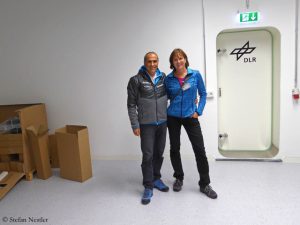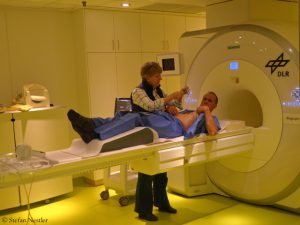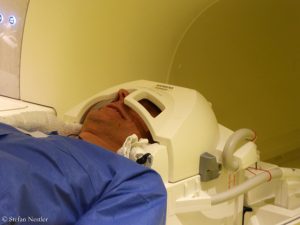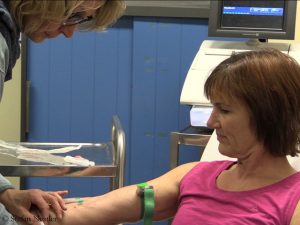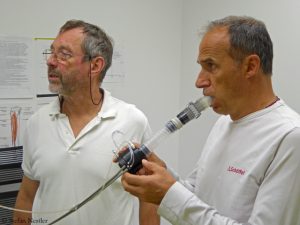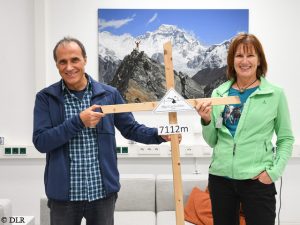Two weeks on a quasi-7000er
This seven-thousander has neither a summit, nor does it offer impressive views. It covers an area of only around 110 square meters – and is located on the grounds of the German Aerospace Center (DLR) in Cologne. A hypoxia chamber within DLR’s medical research lab “:envihab” – the name stands for environment and habitat – will be comfortably furnished in the coming months.
Four weeks in the chamber
In mid-May, Ralf Dujmovits, the only German mountaineer who has climbed all 14 eight-thousanders, and his partner, the Canadian climber Nancy Hansen, will move in there for four weeks. They are taking part in a highly interesting hypoxia study conducted by DLR in cooperation with the University of Texas. The assumption: Although extreme oxygen deficiency threatens life, there could also be a positive effect on the body.
Stronger heart through hypoxia?
US researchers from Texas found in two experiments with mice that heart muscle cells devided when the animals were exposed for two weeks to oxygen deficiency corresponding to conditions at 7,000 m. In mice which had previously been triggered myocardial infarctions, cardiac function improved after two weeks of hypoxia.
Now it is to be tested whether this effect also occurs in humans. For this purpose, Dujmovits and Hansen, both healthy, will spend two weeks in an oxygen-reduced environment comparable to 7,000 meters above sea level, as subjects of the pilot study. “We expect them as healthy, well-trained subjects to increase their cardiac output as well,” says DLR doctor Ulrich Limper during the first of several preliminary examinations in Cologne. For a further study, an experienced mountaineer is being sought as test person, who has already stayed at heights significantly higher than 7,000 meters and in addition has suffered a heart attack. He too is to spend two weeks in hypoxic conditions – of course only after he has completely recovered from the infarction.
Immediate termination possible
Ralf and Nancy first want to pre-acclimatize on the mountains in the Swiss canton of Valais and then go to the hypoxia chamber in Cologne in mid-May. In the first two weeks, the simulated altitude will be increased from 3,000 to 7,000 m by adding nitrogen and thus slowly lowering the oxygen concentration to eight percent (usually it is 21 percent). Over the last two weeks, Dujmovits and Hansen will have to hold out at the equivalent of an altitude of 7,000 m. Unlike in the mountains, however, the air pressure in the chamber remains constant, so that the experiment could be terminated immediately in case of complications.
“Completely crazy”
He has done a lot of research and reading on the findings on long-time stay in high altitude, says Ralf Dujmovits: “In addition, my own experience of many nights in series above 7,000 m have led me to believe that the risk is within manageable limits. And if there are any problems, we can at any time press the red button and stop the study.” Nancy Hansen admits she has a queasy feeling. “Of course I am nervous about the risk! It’s completely crazy to live at the equivalent of 7,000 m for two weeks,” says the 49-year-old. “On the other hand, we can leave the study at any point if we feel too unwell. The bigger question for me is whether there will be long-term negative effects.“
Heart attacks in the family
Dujmovits had started studying medicine as a young man before fully dedicating himself to the mountains. The interest especially in high altitude medicine has remained, says the most successful German high altitude climber. “Being able to contribute to new findings in the field of myocardial infarction research is fascinating as well as exciting. Moreover, I have the opportunity to learn more about my body and its reaction to hypoxia.” Nancy Hansen agrees, adding family reasons for participating in the study: “My father had a massive heart attack 14 years ago. My uncle died of a heart attack. My young nephew has had two, 16-hour open heart surgeries. The topic is really important to me.”
Interesting for earth and space
This also applies to the DLR. “We are not just learning about the limits of the body of highly trained and specialized people who are comparable with pilots or astronauts and can serve as a study model for them, in our case Nancy and Ralf,” says Ulrich Limper, “but we also have the opportunity to improve the treatment of an acute heart disease, what would especially help the patients on earth.”



